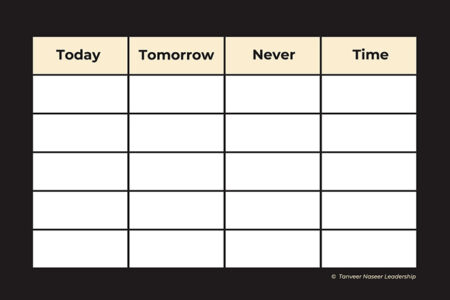“Stop doing busy work and start making a difference with your work.”
This astute observation was shared recently by Liz Wiseman (someone I had the pleasure to speak with many years ago on my Leadership Biz Cafe podcast). And it inspired me to share a simple, but effective strategy that will help you to do away with busywork and focus instead on work that creates value and growth.
Over the past several months, I’ve had a number of conversations with both leaders and employees who told me how they feel as though they’re in this endless cycle of racing to finish one task, only to suddenly find themselves in the midst of another race to finish.
Under such conditions, it can be hard to disconnect from your current reality of busywork to being more mindful, more intentional about how you spend your time. As my physics professor would say, it’s hard to “come up for air” if you’re too consumed with just trying to get to that finish line.
So I’d like to share a simple strategy that will help you break the cycle and ensure your time is dedicated to work that really matters.
On a piece of paper create a table with three columns labelled “Today”, “Tomorrow”, and “Never”, followed by a fourth column labelled “Time”.
You should end up with a table that looks like this:

Under the column “Today”, list all the tasks that you can show a straight line to creating value for your organization today. You have to be as specific as possible with your answer.
For example, this task will help bring in ten new clients for the company. Or this task will help increase revenues by 15% by next quarter. Or this task will help us reduce costs by 12% year over year.
If you can’t define a specific, short-term gain from a task, it doesn’t belong in this column. The only tasks that should be listed here are ones with a specific and clear value add for the organization.
Under the “Tomorrow” column, list all the tasks that you can show are building a foundation for future value. Again, you have to be specific in terms of what kind of future value this will create.
This can be change initiatives that are meant to streamline processes that will lead to a specific decrease in costs to the organization. Or it can be a pilot project you’re taking on to test out a new initiative that is projected to open up new markets for your product or service.
The point is you have to demonstrate tangible, concrete value-add targets that these tasks are expected to create. And like the “Today” column, if you can’t define a future value for a task, it doesn’t go here.
Once you’ve defined tasks for the “Today” and “Tomorrow” columns, put everything else you’re doing in the “Never” column.
And this “Never” column is basically pointing out the tasks you do which might make you feel as though you’re being “productive”, but which aren’t creating conditions for value and growth in the present or future.
Now I know there will be a lot of resistance to putting anything in the “Never” column. And the reason for that is simple – none of us want to feel like we’re not creating value or doing something that matters.
But to return back to the point Liz made in the quote shared at the start of this piece, the reality is many of us are in fact spending a good amount of our days doing busywork, fooling ourselves into thinking what we’re doing is necessary or important.
To be clear here, there’s no question that with these tasks you’re “getting things done”. And we’re not talking about procrastinating or losing productivity thanks to time wasters like scrolling your social media feeds.
Rather, the focus here is on answering a simple question – what are the tasks you’re doing right now that create tangible value for the organization, and what tasks are simply helping you feel like you’re doing something without necessarily creating value?
Often times, these tend to be tasks like getting your employees to generate status reports that whether you read them or not don’t impact what your employees do next going forward.
Or it could be outdated processes that you continue to do simply because you haven’t taken the time to learn about the latest software upgrades that automate certain functions so you don’t have to spend time doing them.
Having facilitated numerous workshops and roundtable discussions with leaders and organizations across a wide spectrum of industries – from the finance sector to healthcare to retail – I know that once we’re honest with ourselves about how we spend our days, it becomes easier to see what we need to stop doing if we really want to feel like we’re making the best use of our time.
I’ll give you an example of a task that should go in your “Never” column – tackling your inbox. I still hear people saying they’re wrestling with their inbox, in trying to get the flood of emails organized and under control. But let’s put this task through this chart we’ve created.
What’s the value you’re creating today in getting to “zero inbox” or a neatly organized one? What’s the foundation you’re creating to build future value in spending time on this?
And this brings us to the last column, “Time”. In this column, write down a rough percentage for how much time you spend – either on a given day or week – on these different tasks.
Again, the only way to get the real value of this exercise is by being honest about where you spend your time.
Once you fill out this chart, you will have a clearer picture of not only how you’re spending your time, but more importantly, what changes you need to make to maximize your time and efforts on tasks that will create value – either for today or tomorrow – so as Liz points out, you can make a difference through the contributions you make.
And this strategy reflects the mindset shared by the most creative, innovative, and successful leaders amongst us.
In fact, if we look at some of the most successful leaders of the past 20 years, one thing we’ll see they share in common is a laser-like focus on a few simple goals. To them, everything else doesn’t matter and isn’t worth their time.
While their accomplishments are certainly impressive, they’re not herculean in nature. That only those who breathe rarefied air or who were gifted with a certain set of genes are able to achieve.
Instead, it just comes down to being intentional about how we choose to spend our time. And yes, it is a choice.
And by the way, this also works for employees who have to deal with a boss who keep sending down additional tasks they deem “critical” or “urgent”. Or maybe it’s a more senior leader in your organization you report to whose requests are serving to define what tasks you focus on over the course of your work week.
In both cases, you can use this exercise to show your boss how you’re spending your time and where you can suggest changes about how you can maximize the value you’re creating for the organization – and what tasks you need them to recognize are only serving to waste your time and talents.
It’s a powerful and empowering call to action that Liz encourages us to take on – to recognize that all of us have a choice about how we choose to spend our time; of whether we just go with the flow and leave our days to be consumed by busywork.
Or whether we become more intentional about how we move through our days so as to make sure we’re focused on doing work that’s meaningful and impactful.
It’s a tall order for sure, especially as demands on our attention and resources continue to grow.
But if you give yourself time to do this exercise – and be honest with yourself about what you do and how you spend your days – you will not only become more successful in your leadership, but you will also find your time is being spent on more rewarding and fulfilling work.

